At some point during the game development and game design process, you’re going to be faced with a terrifying prospect: having to have another person experience the game that you’ve made. It’s never an easy thing to put yourself out there like that, but it’s an important step to take if you have plans to release the games you make to the wider public.
The first way someone will probably see your game, though, is as a playtest. Playtests are an essential component of the game dev process – from the smallest project to the largest. They’re essential to all of game design, because every game developer or game development team needs to hear the perspective of people not involved with the actual development process. Not only does it help cut through biases that you may have about your work, but there are a lot of things an outsider can spot that you just can’t just given how long you’ve stared at the project.
Given the importance of this step, in this guide we will talk about how you got about playtesting your game. We’ll explore methods, tools, how to find playtesters, how to get the feedback you need, and how to use the feedback you get.
Everything here will be geared towards assisting those pursuing solo development, or developing in small teams with little to no budget, with some advice specifically for people developing in Unity. However, even those outside this scope may find tips inside to better help them with their game design. Hopefully by the end, you’ll be equipped to go forth and playtest.
Let’s get started and learn how to playtest your game!
Concepts:
- Identifying Your Needs
- Acquiring Playtesters
- Tools and Methods
- Tips and Tricks
Identifying Your Needs
The first thing you need to do when planning a playtest is figuring out what you want to get out of it. You’re seeking feedback from players, but what kind of feedback will be the most useful to you as the developer? What do you need from your players, that will best help you to improve your game? To figure this out, let’s break down the various types of feedback that you can easily collect working solo, or with a small team:
- Bug reports
- Player engagement
- Data and statistics
- Gameplay screenshots and footage
- Feedback and advice
To determine what kind of feedback will be most useful to you, you need to be acutely aware of the game that you are making. For example: if you’re making an intimate and personal narrative experience, or a deeply artistic and inspired piece with a lofty message, then very detailed feedback from a few playtesters will probably be the way to go.
Conversely, if you’re aiming to make something that lives and dies on gameplay balance, then large sums of data from a diverse population will probably suit your needs more closely. Depending on which of these you’re seeking, you’re going to go about collecting your playtesters and running your playtest differently. So let’s start there: how to collect playtesters, and what to do with them.

Acquiring Playtesters
Getting people to playtest your game for free can be challenging. Doing QA is legitimately a job that one can aspire to in game development. So understand that what you’re asking of your playtesters is essentially free labor and approach gathering playtesters with that in mind.
The first and easiest place to start is people who are already aware of your game. Peers, mentors, collaborators, and even friends or relatives that you’ve bragged about your game to. Among those people, you’ll want to consider a few things:
- Their relative investment in the project
- The amount of free time that they have
- Their experience with games as a medium
If a person has very limited free time, you may not wish to detract from that by asking them to do work for you. That is unless they are heavily invested in the development and success of your game, such as a collaborator who has provided music and wants to see their work being put to good use. To that end, always try and show your collaborators that their work is of value to the project. There’s no feeling better than seeing the joy on someone’s face when they see how they’ve contributed to something cool.
It’s also valuable to get players with varying levels of experience gaming. You’re going to get vastly different data from someone who plays League professionally than you will from a family member who has only played Wii Sports at family gatherings.
Similarly, people who you’ve told about the game are going to have preconceptions about what you’re doing. People going in completely blind is not inherently more valuable, but getting both is more valuable than either one alone.

You also want to consider how many playtesters you’re going to want, because that will affect your methods (which we’ll go into in a moment) and also the means by which you gather playtesters. Using your social circles to get maybe up to a dozen playtesters is fantastic for certain types of games, but others will require large sums of data to identify trends and balance for the largest number of people.
To that end, you’d want to be using social media (Twitter is the platform where game devs do most of their communications), posting about your game in game dev communities (you’ll find dozens of subreddits, forums, and Discord servers for this sort of thing) and potentially even reaching out to journalists (Gamasutra, Rock Paper Shotgun, and Polygon, among others, will often post about in-development games).
Tools and Methods
So you have your playtesters. Now you’re going to want to set up your playtests, and for that you’re probably going to need some tools. Especially in the current environment of social distancing, any tool that doesn’t require you to sit across from your playtester and ask them questions is your best friend. So, what methods should you employ, and what tools would I recommend for them?
Well let’s look back at our different types of feedback and list off a few for each:
Bug Reports & Player Engagement
The preferred method for measuring Player Engagement is a questionnaire. Ask your players questions about their experience with your game. Try and make them think hard about their experience.
Google Forms is my software recommendation for this sort of thing.

If Google Forms isn’t your cup of tea, some alternatives include:
Data and Statistics
The easiest way to collect important data for your game is through the use of analytics software. This enables you to balance and test individual mechanics, map trends in player behavior, ensure that players are seeing all of the content you want them to see.
Most game engines have first-party analytics software, and I will be talking specifically about Unity Analytics later in this piece.

Gameplay, Screenshots, and Footage
Recording gameplay footage of your playtesters can be incredibly insightful. You probably spend so much time with your game that you play it in a way no normal person would, so being able to see what players actually do when given control and left to their own devices can open your eyes to things you never would have spotted otherwise, and, you can potentially even use the footage you collect for marketing (more on that later).
The best free screen recording software is still Open Broadcaster Software.

Feedback and Advice from Peers and Mentors
Much of the time the most valuable advice you can receive is from someone who has been where you are and made the mistakes you’re liable to make. So if you have access to professionals, and they’re willing to give you the time, use that.
While there’s no software that can substitute for a professional’s genuine advice, there are thousands of hours and millions of words of tutorials by professionals in the field out there. I’ll link to some relevant ones in the Further Reading section at the bottom of the page.
Neat Tips and Tricks
I’ve run a few playtests in my time, and I’ve accrued a good number of tips and tricks for general use by the aspiring playtest aficionado, particularly for the tools outlined above.
Google Forms
Google Forms gives you a range of different question types from multiple choice, to scales of one to five, making their service highly customizable for a variety of different use cases. I’m here to tell you, however, that the only one you care about is the “Paragraphs” answer type.

Obviously this isn’t a hard and fast rule. If you have hundreds of playtesters, you can probably get away with asking the player to “rate your engagement on a scale of one to five” and get some significantly useful data.
If you have a sample size of say five to ten, however, then you need to ask questions that interrogate in specific the experience that players are having. You want to put the player being asked the question in the position of being unable to give you a lazy answer.
My master trick for doing this is simple. Take the question you think you want to ask about the game and rephrase it as a request for something about the player’s experience.
For example:

… becomes:
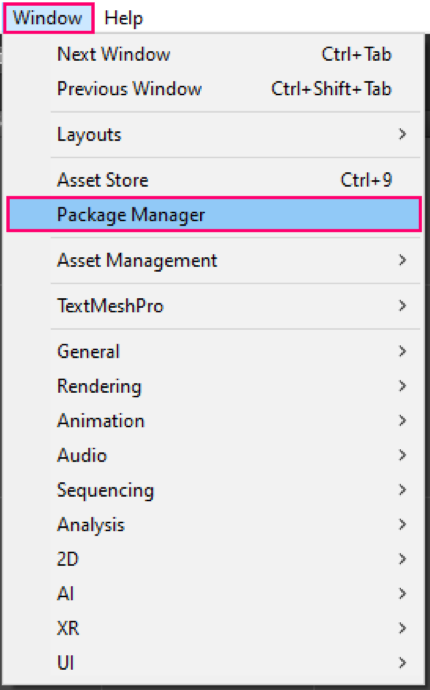
This prompts the player to interrogate their own experience and give you a more detailed answer. It also prompts them to consider things that they did, rather than things that just happened in the game.
Due to the specificity and detail these questions ask for, usually you want to aim for the sweet spot of 3-5 questions of this type so as not to exhaust your playtesters. Here’s a playtest questionnaire for this article that I mocked up, just so that you can see how I would structure it.
https://forms.gle/Cr8TcTDWdrErQ7NZA
Unity Analytics
Unity Analytics works in a way that can be somewhat obtuse to a first time user, but gets easier once you’re through the initial setup. So:
The first thing you’re gonna want to do is open up the Unity Package Manager by going Window > Package Manager.

Wait for the packages to load in and install the Analytics Library package.

Then under Window > General, you’ll find the Services tab (which can also be accessed with Ctrl+0).

You will need an account with Unity to access Services, so run through the setup process for that if you don’t have one.

Once you’re in, you’ll need to create a Project ID and then click on Analytics once Unity has finished doing that.
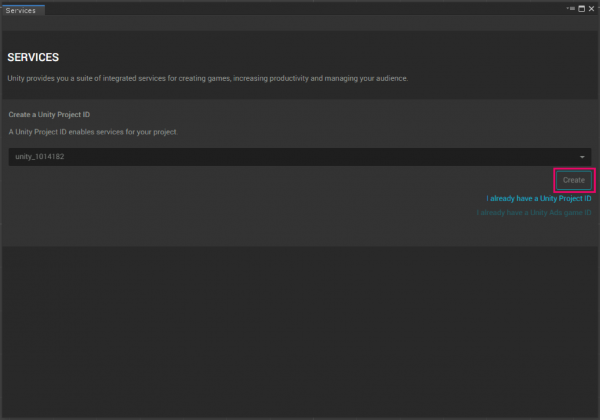

Then you’re going to enable Analytics. For legal reasons, you are required to indicate whether your app is intended to be used by children under the age of 13. This will limit the kinds of data that you are legally allowed to collect on your users (for further reading on this, go here).

From here you can access your dashboard in browser, where you have access to all of your data with some room for delay as events are transmitted and compiled.
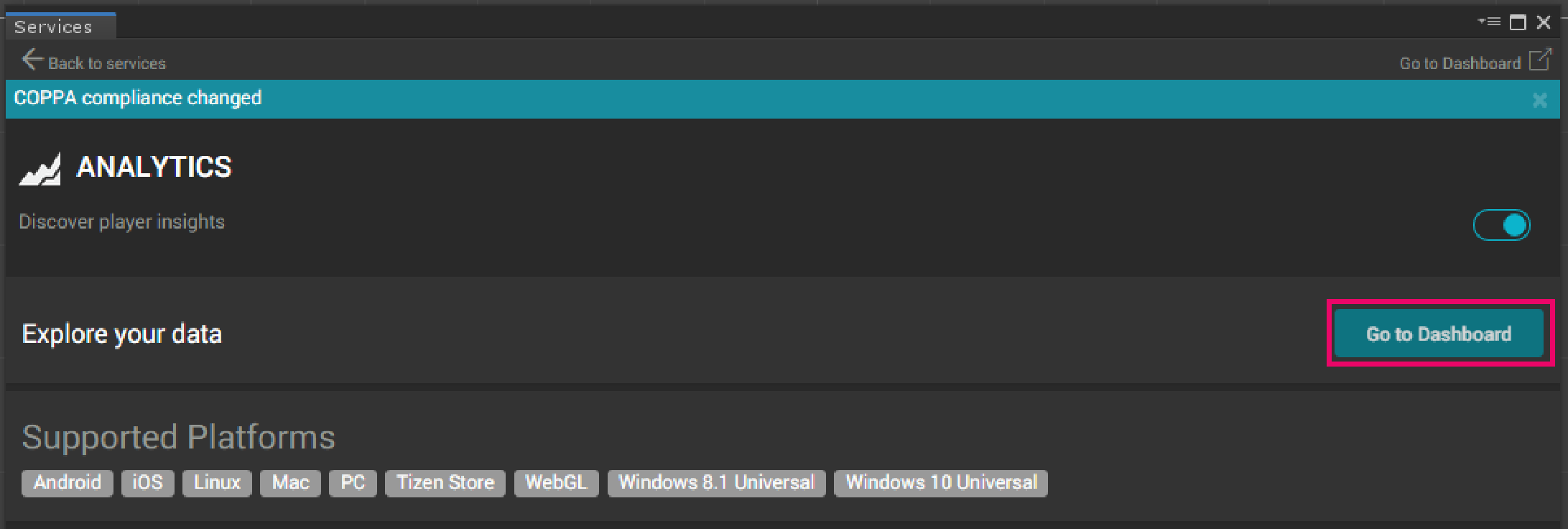
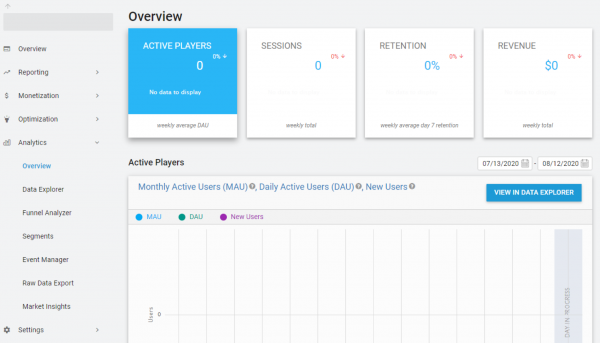
The tabs that you care most about here are the Event Manager and Data Explorer. The former displays every unique event that has been received from your game (to make sure that all of your events are actually sending), and the latter visually displays the data collected in a variety of helpful ways.
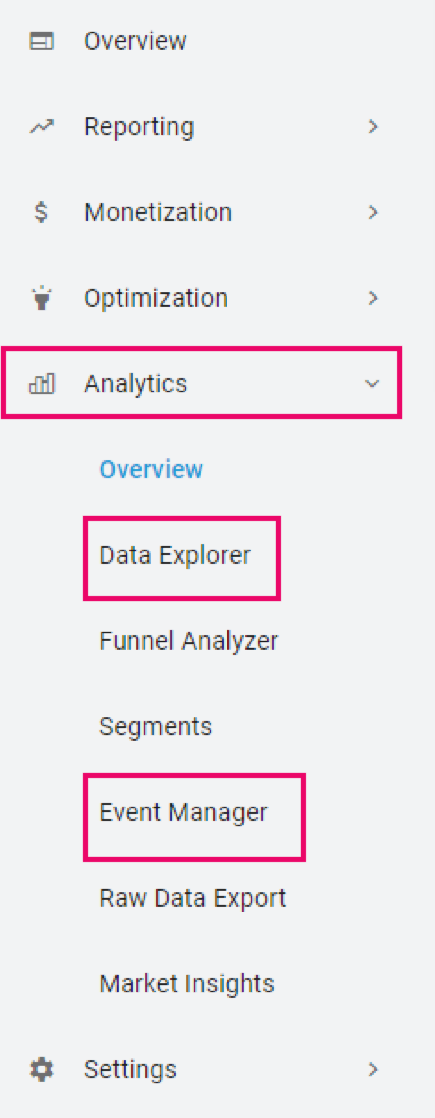
Setting up events is, comparatively, the easy part. It’s essentially one line of C# code that you place at whatever point in your game you want to transmit an event from. This can be when players meet basically any criteria.
// First reference the Unity Analytics namespace
using UnityEngine.Analytics;
// Use this call wherever a player triggers a custom event
AnalyticsEvent.Custom(string customEvent, new Dictionary<string, object> { { "parameterLabel", parameterData } });Keep in mind that Unity analytics can only transmit so much data: 100 events per hour per instance of your game, 10 parameters per event, with only 500kb of data for the event name (100 characters max). A helpful tip is to limit event parameters and names to single characters or acronyms, to be as efficient as possible. For instance:
// This event is transmitting the total number of objects a player has touched in a scene
// The number transmitted will be an int, in this case the number of objects in the "objectsTouched" list
// The parameter name is "OT" to indicate that this is "Objects Touched"
Analytics.CustomEvent("EventStarted", new Dictionary<string, object> { { "OT", objectsTouched.Count } });Miscellaneous
If you’re not setting up the playtest because, for instance, you are social distancing due to the current world climate, and thus need your playtesters to download and install software like OBS to collect footage, you’ll need to provide instructions on how to do so.
Put a space in your questionnaire for them to provide you with a link to the uploaded footage. Also, put a question in there where they will indicate if they’re okay with the footage they recorded be used for marketing purposes, and lastly a field for them to indicate if they would like to be included in the game’s credits (these last two points aren’t strictly necessary, but it’s polite and good optics).

Always, always, always provide clear instructions on how to participate in the playtest. Be exhaustive about it. Even if you think you know that your playtesters understand how .ZIP files work, and how to set up a screen capture with OBS, you always want to be prepared for the one time you’re wrong.
Lastly, when reading and interpreting feedback, you’re going to probably have moments where you experience either strong positive or negative feelings about your work. It can be extremely validating to hear that people like the thing you made, likewise it’s easy to feel like you’re somehow failing if people aren’t engaging with your work.
The important things to remember are that you are not your work, that your work as it is is not the way it always will be, and that your playtesters aren’t necessarily right about your work anyway. Take heart in the fact that you’ve made it to the point of having work to show for your efforts, and in the fact that it will be even better for the next playtest. Also, don’t be afraid to shake things up and change course if things aren’t working for you the way that they are.
Conclusion
Playtesting, like most things, gets easier the more you do it. You will become comfortable with your own rhythms, and figure out what works for you over time and with experience. However, if you’re just starting out and not sure how your first playtest is going to go, hopefully, this piece has given you a few angles to start approaching this from so that you can make all of your games the best that they can be.
Remember that these techniques can be scaled and adjusted as well, so don’t stick to one formula. Like game design itself, mastering how to playtest your game is an ongoing challenge filled with a lot of trial and error. Nevertheless, it is something everyone, even solo developers, can do, so we can’t wait to see the games you come up with and improve using the techniques above!
Good luck with your playtests, and get that dream game project out there!
Links
- Unity Analytics
- Custom Analytics Events
- Analytics Event Limitations
- Best Online Form Builder Software
- Open Broadcaster Software
- Legal Requirements of Websites and Apps for Children
- James Everett on showing your collaborators how you’re using their work
- The Making of the XBOX Adaptive Controller




